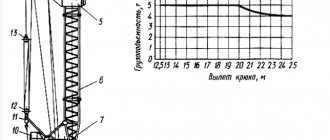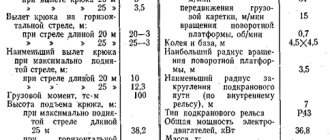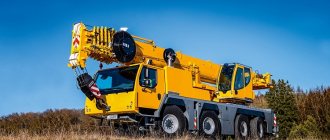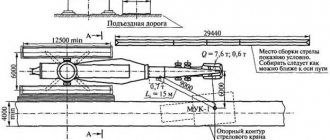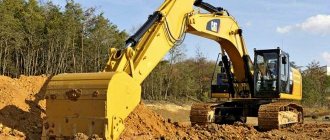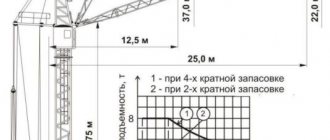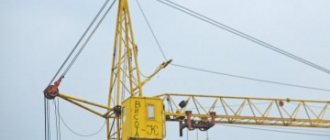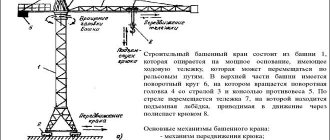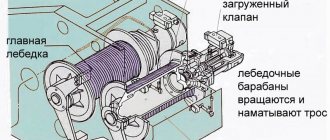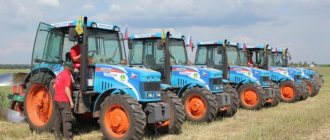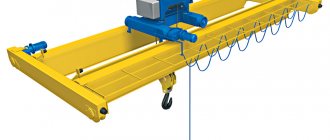The KB-408 tower crane is a special rail-mounted equipment that is used to mechanize construction work at a height of up to 72.7 meters and with loads of up to 10 tons.
The KB-408 tower crane is a construction mobile full-rotating rail-mounted crane with a rotating tower and a beam boom with a load trolley, providing vertical and horizontal transportation of construction parts and materials. The crane is transported from site to site disassembled. Installation is carried out using our own mechanisms and using a truck crane.
The KB-408 crane belongs to the 4th dimensional group of tower cranes and has the same main components as the cranes of this group.
The boom design is sectional. The crane boom structure is made of metal pipes in the form of a lattice structure; the boom modules are connected to each other using flange connections. The KB 408 crane can be mounted with an inclined boom. The reach is changed by moving the carriage.
The crane tower has a modular design. The number of tower modules on KB-408 cranes varies from 2 to 5 pieces. (depending on the crane version).
Purpose of a tower crane
Such devices include a lifting mechanism that has a rotating boom, a winch and a counterweight. The boom is attached to the top of the tower. It represents a load-bearing support made of metal. The most common type is the construction tower crane. They are capable of performing the following actions:
- lift heavy loads to a given height;
- move cargo within the construction site;
- unload and load vehicles.
Modern tower cranes are capable of solving a wide range of tasks in various conditions.
The structure of a tower crane and the principle of its operation
Each mechanism consists of a similar set of elements. The tower crane structure includes:
- supporting part (base);
- rotating device;
- a horizontal guide (boom) along which the lifting winch moves;
- vertical stand (tower);
- cabin with controls;
- chassis (mechanism for moving the entire unit).
The operating principle of a tower crane is based on lifting an object of permitted mass using a cargo winch. This design provides the necessary total moment of the weight of the boom and the counterweight with the weight of the fixed object. The counterweight can consist of several stacked elements, for example, reinforced concrete structures. As a result, the sum of the so-called stabilizing moments must always exceed the sum of the overturning moments. Based on this position, the required boom reach is calculated. Ensuring the maximum coverage area necessary to move the cargo is achieved by extending the boom, turning it horizontally, moving the cargo winch and moving the unit itself.
Scope of application
With the help of KB-403 (alternative designation Kbk-160.2), all installation and construction work became mechanized.
KB-403 is also used in grain elevators and industrial enterprises , factories and power plants .
Lifting height of heavy weights up to 8 tons = 57.5 m. The crane performs all vertical and horizontal movements of building structures and materials at the work site to the desired location.
Specifications
The operational capabilities and scope of such devices are determined by the following characteristics:
- the size of the boom increase (it is measured in meters and ranges from twenty-five to forty meters);
- load lifting height (individual cranes can lift loads one hundred meters or more);
- load lifting speed (this parameter reaches 200 m/min);
- a parameter that determines the rotation of the tower (from 0.2 to 1 rpm);
- speed of movement of the chassis.
The listed parameters are determined by the list of tasks to be solved. All types of tower cranes comply with the accepted classification. It is approved by existing standards.
The marking includes a sequence of capital letters and a set of numbers. The first three letters indicate the type of product. For example, K (crane) B (tower) M (modular). The following numbers indicate: group number, type of base model, serial number of the entire unit.
- The group number determines the magnitude of the load moment.
- The appearance of the base model indicates whether the tower is rotating or not. Numbers from 01 to 69 indicate mechanisms with a rotating turret. Rooms 71 to 99 with fixed tower.
- The serial number of the design indicates design changes.
At the end of the marking the climatic version of the specific product is indicated. For example, the letter “U” indicates the use of a crane in a temperate climate, “HL” in a cold climate.
Classification
Tower cranes are classified according to the following indicators:
- areas of tasks to be solved and scope of application;
- load capacity;
- type of tower mounted;
- type of installed boom;
- type of chassis;
- mobility.
The main areas of application are:
- construction of objects for various purposes (residential buildings, industrial facilities, hydraulic structures and much more);
- loading, unloading, moving cargo to the work site.
The lifting capacity of the crane depends on the load moment for which the unit is designed. For example, for a load moment equal to 10 tm, the load capacity is 15 t, for 40 tm it already reaches 80 t, and at 120 tm the total load capacity is 250 t.
In terms of mobility, such a mechanism can be stationary or mobile. The degree of its movement depends on the type of chassis.
Depending on the design, each crane has its own advantages and disadvantages. The advantages are determined by the technical characteristics specified by the manufacturer. Disadvantages include those limitations under which the crane is unable to perform its functions. This is usually associated with carrying capacity, mobility, and the amount of financial costs for its operation.
By tower type
The following types of towers are used for modern products:
- constant length;
- telescopic;
- grown from below;
- with variable rotation angle.
The first type has a fixed height. It is installed in a vertical position and then fixed. A tower crane with a rotating tower is capable of rotating around its axis.
By arrow type
Modern units have the following types of such devices:
- lifting boom (allows you to change the lifting angle);
- beam type system;
- articulated design.
In the first type, the boom reach is adjusted in the horizontal plane by rotating it relative to the hinge. They have high maneuverability, load capacity and high lifting height. They are quite easy to transport.
For beam structures, the boom reach is adjusted by moving a trolley equipped with a towing device. This significantly complicates the design and increases weight. However, in this case the size of the working area increases.
The latter type of units is highly versatile. They are capable of adjusting the boom reach in both ways (increasing the lifting angle and the length of the horizontal guide). This expands their capabilities, but significantly increases their cost.
By installation method
Types of tower cranes have the following design:
- stationary;
- self-elevating;
- mobile.
The first category includes mechanisms that are installed in a predetermined location. No possibility of movement. They are mainly used on construction sites.
Attachable cranes are used to lift loads on high-rise structures. Some of them are self-elevating.
Mobile cranes include all units equipped with a running gear. They have good maneuverability, which increases their operational capabilities.
By type of running mechanism
For mobile vehicles, various types of running devices are used. The most effective are:
- automobile and chassis based on wheeled trolleys;
- tracked;
- rail;
- walking;
- pneumatic wheels.
Products on cars or car chassis are used for loading and unloading operations, lifting light loads at construction sites or logistics centers. The tower rests on a car chassis, which makes it quite easy to move such a mechanism over long distances. If it is necessary to carry out such work on unequipped sites or soft ground, a crawler chassis is used. They have less mobility, but greater maneuverability.
One of the original running devices for heavy mechanisms is the so-called walking system. It combines a rail structure with special support elements. It is made in the form of several cylindrical support shoes. The movement of the entire unit is carried out using electric motors driving the wheel system. Some designs use a base plate and two skis as the propulsion mechanism.
The most widespread are tower cranes moving on rails. They are laid at a slight distance from the object under construction in such a way that it is possible to ensure the lifting, lowering, and movement of cargo throughout the construction site. Expansion of possibilities is achieved thanks to installed rail access tracks. The movement is carried out using an electric motor that drives a wheeled cart.
Device
This model is included in the V category of cranes, its design coincides with similar models of this group.
The lift mechanism is arranged section by section using iron profiles welded in the form of a lattice. To change the reach: increase or decrease it, move the carriage.
The design of the KB-408 forklift consists of:
- rotary single-row devices, platforms;
- portal;
- telescopic tower rotating 180 degrees;
- operator cabins;
- beam-type booms with a cargo trolley, with its help lifting the load is possible in both directions: up and down;
- running frame;
- additional details.
Rotary: single row device, platform
The portal is installed on top of the platform, where there are also 2 types of winches:
- rifle,
- cargo
A counterweight in the form of 10 reinforced concrete blocks is mounted at the rear of the platform , thanks to them the turning mechanism does not swing when moving.
Struts and racks are mounted in the truss elements.
The platform has a base and is attached to the chassis by means of a slewing bearing.
Recently there have been design changes in KB-408, with regard to the structure of the rotating device; outwardly it looks like a circle with a diameter of 2500 mm.
Additional parts - support hinge, working struts and other elements.
You will also be interested to know the technical characteristics of the Ivanovets 25-ton truck crane, a review of which is presented in the next article. And here we will talk about the “Galichanin” with a lifting capacity of 50 tons.
Portal
The portal is arranged in the shape of a tetrahedron. On both sides it is open for the movement of tower parts. It is supported by a truss element and telescopic struts. Created from 2 trihedrons. The fastening between them occurs using box-shaped beams.
It is through the portal that the process of increasing height and a stable position in the space of the tower is possible.
It has a roller mechanism located in two rows and four locking elements that can keep the tower from falling during installation of the crane.
Tower
The turret design is similar to that of the K-160. Represents:
- head,
- inventory, head sections,
- spacers
Heading
The tower element is constructed like a metal lattice. Has racks, ladders, platforms.
At the very top of the head, a boom beam and a cargo rope are attached. There is a lightning removal device and an anemometer.
Head section
Blocks of two ropes are attached to it to move carts and loads. A signal light is installed at the top, and buffer stops for trolleys are installed at the bottom.
Control cabin
The device is held on special mounts at the top of the tower. It consists of a cabin for cranes operating at a height of no more than 20 meters. Compared with its predecessor, the K-160 has improved technical devices and heating panels.
Beam boom
The individual structural elements are welded and interlocked using flanged parts. The elements themselves are made of metal. They move the trolley moving the load. With the help of the latter, the arrow's reach is changed.
Running frame
The structure with dimensions of 7.5 x 7.5 meters (four-ring frame) contains rotating weather vanes on which the trolleys are supported. The switch is mounted on the running gear of the crane.
Weathervanes have two states:
- transport;
- working.
There are 4 trolleys for the crane. A couple of them use an electric drive, the rest do not.
Rails for KB-408 can be used in two types:
- rounded;
- straight.
The peculiarities of these mechanisms lie in the position of the main control trolleys. On a straight type of rail, everything is on the same axis. On a rounded one - outside the center of the rounding.
Additional details
As additional parts, KB-408 has various elements: brace, hook part and mounting device and other fasteners:
The cargo winch has a drum mechanism, brakes, a gearbox, and an engine. They stay on the platform. The latter is attached using four screws. The purpose of the winch is to move the load vertically.
Trolley winch , the components are the same. The two-speed motor ensures precise guidance of the load over the installation site.
The telescopic strut is constructed from pipes of different diameters, nested one inside the other. They provide balance and support for the tower when installed on the platform.
The crane strut is in the form of a triangle and is attached to the top of the tower. Helps to install the tower and deflect the brace cable away from the tower. The spacer contains 4 axle blocks, a guy rope, a rope part for moving loads, and a device for mounting a load sensor.
The crane is transported in a disassembled state; it is mounted on site using existing mounting devices.
The crane is moved using a rail mechanism. KB-408 have counterweights to the tower, located under the latter.
In order to increase the maximum lift height to 77 meters, the boom is tilted at an angle of 30 degrees. The maximum boom reach in this case will be only 50 meters, the load capacity, however, in this case is only one and a half tons.
For maintenance of the KB-408 there is a platform that is fixed to the base of the boom.
